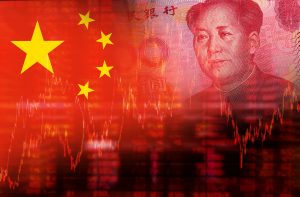
Economic & Market Update, December 2023
Richard Morey
 The Growth Rainbow
The Growth Rainbow
It seems like things have always been this way. Yet the longest economic and market growth cycle in US history may finally be ending. This cycle had one serious bump along the way called a pandemic, but in retrospect that was only a two-month economic/market drop. The ensuing stimulus package, the largest cash transfusion ever bestowed upon almost all US citizens, jump-started the growth cycle back to life.
Rather than focusing on the evidence for a contraction (for example, the largest survey of manufacturing showing a decline to recession levels), let’s begin by examining the largest factors keeping the economy afloat.
Consumer Spending
Buoyed by rosy financial media narratives (of the same type, by the way, that preface virtually all downturns), consumers appear to be optimistic. For example, we hear that online sales on “Cyber Monday” were $12.4 billion, up 9.6% from last year. That’s big growth.
Of course, we don’t have holiday sales numbers yet for the much larger physical stores sector. Their sales have been trending down over 3% month-over-month as of November 23rd. Moreover, much of Cyber Monday sales were in a category called “Buy Now Pay Later” or BNPL. This category of debt used to be small. This year it leaped up 42% on Cyber Monday alone.
Consumers who are buying their holiday gifts through BNPL have either:
- Maxed out their credit cards and can’t get any more of them or,
- Don’t qualify for any other type of credit, including credit cards.
Though it’s unlikely to make a dent in BPNL levels, the Bank of International Settlements just issued a warning that Buy Now Pay Later growth may lead up to 10 million US consumers into insolvency in the next 3-6 months. Keep in mind there are currently well over 50 million such borrowers in our country, with the number spiking upwards in recent quarters, months, and days.
Listening to the CEOs of Wal-Mart & Target speaking about consumer spending trends each quarter is for me quite instructive. For the last two years, Wal-Mart in particular has seen their business do quite well. Target has had some struggles but remains reasonably well-positioned. Their views on consumer spending present a vast amount of real-time data on the topic, covering the entire country and all age groups.
business do quite well. Target has had some struggles but remains reasonably well-positioned. Their views on consumer spending present a vast amount of real-time data on the topic, covering the entire country and all age groups.
If you listen to a recording of last month’s call from either Wal-Mart’s CEO Doug McMillon or Target’s Brian Cornell, you’ll hear a clear description of consumer retrenchment among all income strata. The exception, of course, are those enjoying a degree of affluence who rarely shop at either place. This group’s spending appears to also, however, be contracting as we see the index of high-end retailers now slumping badly.
How is this high-end slump related to Target and Walmart? According to Target CEO Brian Cornell, one of their biggest growth areas continues to be people earning over $100,000 now shopping at Target to lower their grocery bills. Good for Target – but he sees this as one more worrying sign of a deteriorating consumer spending landscape. Of course, both CEOs say the spending changes are most pronounced at the bottom – where people are switching away from everything but the cheapest food they can find.
Employment
While I put a lot of stock in what the CEOs of Wal-Mart & Target say about consumer spending, one should put absolutely no stock in employment numbers. The headline employment number put out each month by the Bureau of Labor Statistic, called the Establishment Survey, must be the most absurd example of measuring employment ever devised. It almost always, in retrospect, turns out to be wrong regarding every single economic turning point.
 I’ve discussed this many times over the years in these articles so won’t bore the reader with the statistical farces used to generate the headline employment numbers.
I’ve discussed this many times over the years in these articles so won’t bore the reader with the statistical farces used to generate the headline employment numbers.
There is, however, one exception that reveals the employment picture quite well. The total number of hours worked has gone down this year – a trend that began in 2022. (www.bls.gov/news.release/empsit.t18.htm). At least one of the regional Federal Reserve Boards now predicts it to continue to fall next year.
If you think about it, the total number of hours worked, and the income associated with those hours, are all we need to understand the true employment picture. Both have been falling slowly all year.
Domestic Summary
When total retail sales come out in January that includes brick and mortar stores, we may still see it falling further than most analysts expect. All we know thus far for sure is that, sometime in the next few months, a large group of BNPL participants likely won’t be keeping their Christmas presents.
We also know the employment news is now beginning to mirror the facts as pointed out by looking at a declining number of hours worked. These facts include a huge (350,000+) decrease in holiday hiring previously announced, rapidly increasing corporate layoffs, and a plunge in job openings per unemployed person (one of the largest drops ever). Even the Establishment Survey numbers are now being revised lower for previous months.
And how is the World’s Second Largest Economy Doing?
This morning I read a headline in the Financial Times that read: Chinese Borrowers Default in Record Numbers as Economic Crisis Deepens (by Sun Yu in Beijing, December 2 ).
The first thing to note is the Financial Times uses the terms ‘crisis’ to describe what’s now occurring in China. The borrowers mentioned in the headline who are defaulting include local governments, corporations, and individuals.
Sun Yu describes what I have been predicting would occur in China once their Ponzi-like, entirely debt-fueled, real estate boom went bust. My thesis has always been that you simply cannot create unlimited wealth by building things  you don’t need using borrowed money, no matter how powerful a central government’s control. Ultimately, that practice must lead to enormous losses – especially in a country where most of the populace has nearly their entire net worth in real estate.
you don’t need using borrowed money, no matter how powerful a central government’s control. Ultimately, that practice must lead to enormous losses – especially in a country where most of the populace has nearly their entire net worth in real estate.
Unfortunately for the Chinese populace, their government has now nearly perfected surveillance and population control – of all types. Having clamped down – very hard – on all their entrepreneurs, and the rights and prospects of their average citizens, the country is now experiencing something you may soon be hearing more about. They are experiencing “the malaise,” in which the people are giving up hope. The young now see no prospects, with tens of millions living on their couches at home. They can’t protest, so they do nothing. Now, according to this article, many millions of their parents are facing destitution. And there is no safety net in China.
It’s an added grim irony that, to stave off its demographic time-bomb, China has pivoted from their draconian “one child” mandate to offering child-bearing incentives to young women, with little success apparently because of this same malaise.
All the above should be highly deflationary here in the U.S., and therefore very good for bonds. My concern for stocks stems from the belief what’s going on in Chinese debt will jump to Europe and then the United States. Still good for high-quality bonds but terrible for everything not negatively correlated to risk.
Conclusion
My concern is that it will turn out to be impossible to have a debt liquidation event in the second largest economy without it spreading to other countries with debt bubbles (like the EU and US). If so, we’ll soon see the world’s debts cross borders in unwelcome ways – meaning losses for our financial institutions.
Until then, we believe investors should be invested, first and foremost, safely. If a global debt liquidation gains traction (China, then Europe, then US is the most likely order), I expect to make changes to benefit from it and increase our returns. Until then, we’re satisfied to sit safe and make 6% or so in interest.
~ Wishing you the happiest of holidays ~
Richard on behalf of the Secure Retirement Team
